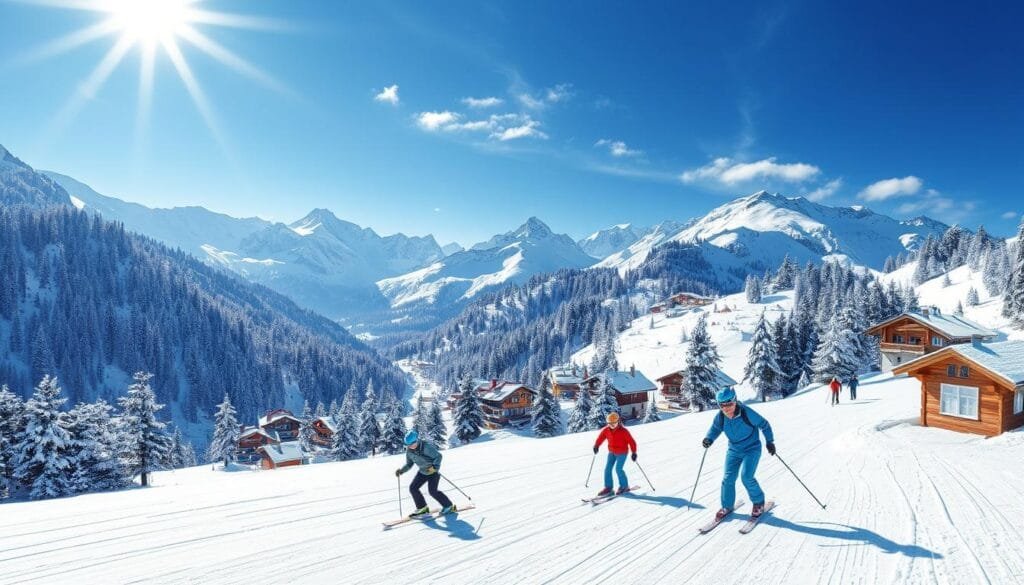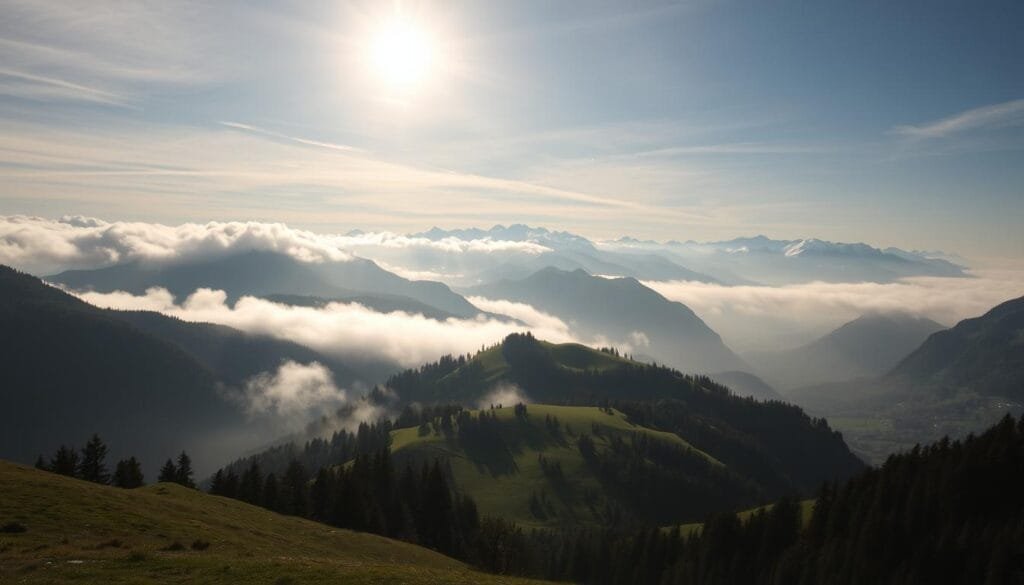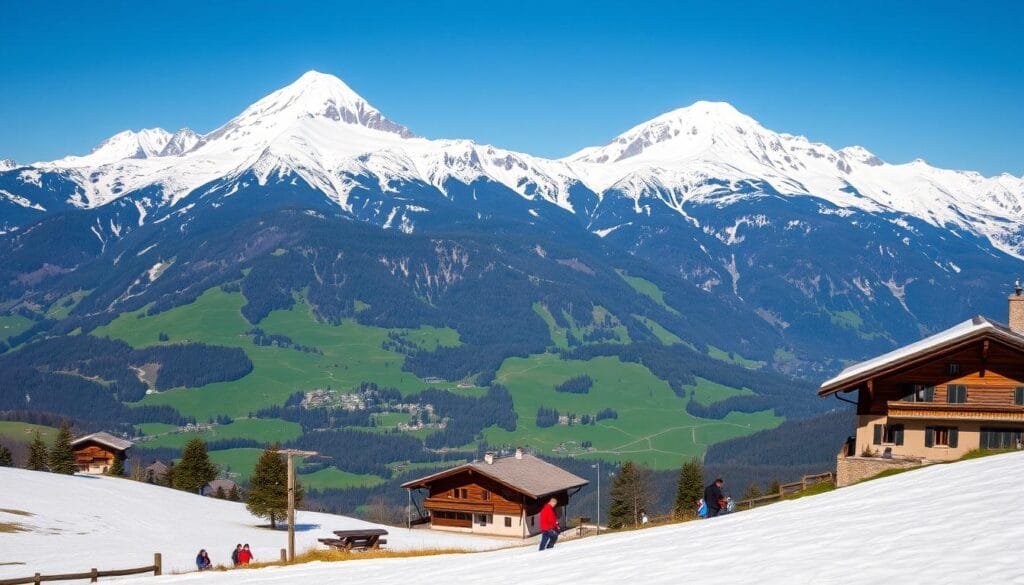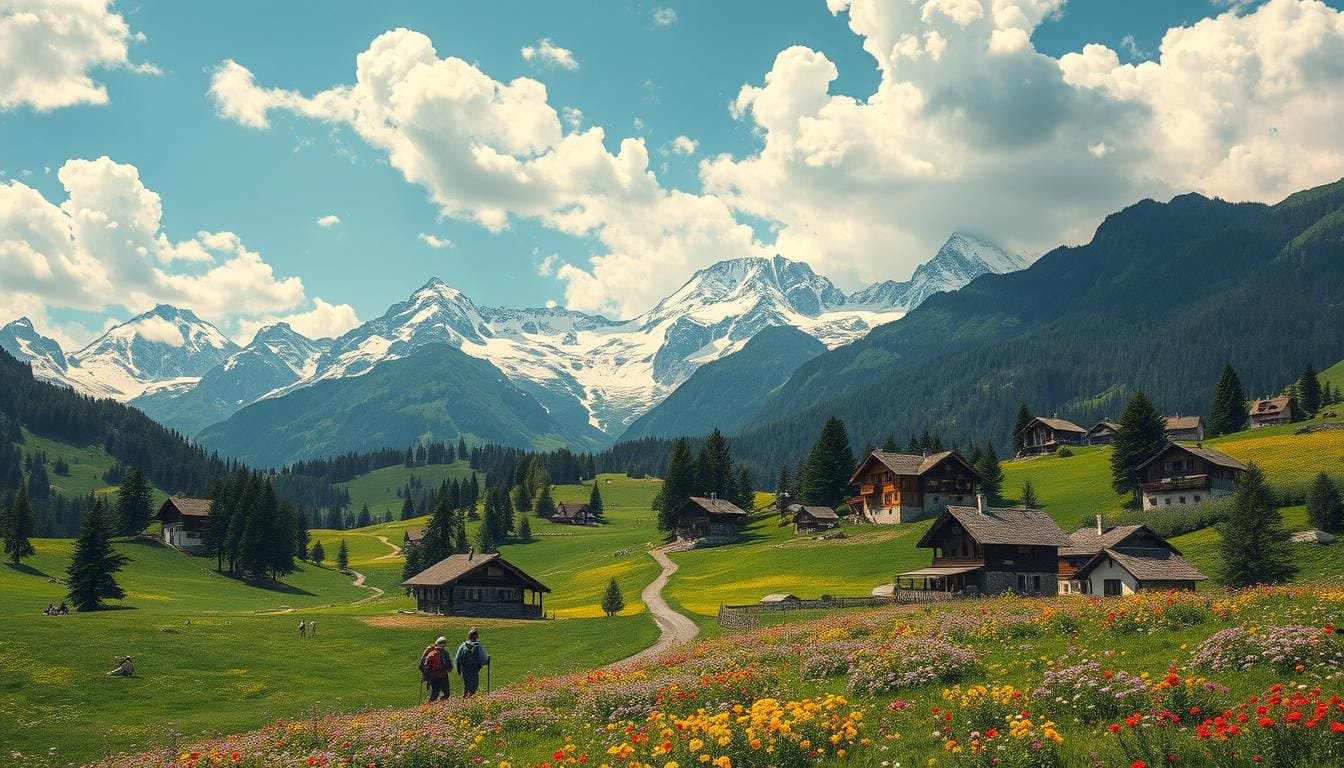Ever thought about how Switzerland’s different climates affect its culture? This question leads us into how the environment and culture connect deeply in Switzerland.
In Switzerland, climate and culture are closely linked. This relationship touches everything from daily life to traditions. The alpine weather plays a big role in shaping Swiss traditions and how people live.
Seasonal changes are vital to Swiss culture. Cold winters bring winter sports and draw tourists. Meanwhile, mild summers are perfect for festivals and being outdoors. These weather conditions affect not just activities but also how people connect.
Switzerland has varied climates that come together to form a rich culture. It mixes influences from different air currents. For example, city festivals differ from the mountain regions’ more practical traditions. The weather influences all of these.
Avalanches are common in Switzerland, with about 10,000 happening each year, mainly from February to April. They show how climate knowledge is crucial for everyday life and policy. This climate-culture connection highlights how the environment influences society.
When looking at countries in the Global South, we see climate challenges impacting development. This stresses the importance of climate in discussions on global inequality. For more insights, check out environmental determinism in Switzerland.
Let’s explore how Switzerland’s climate affects its culture. We’ll see how weather shapes daily life and traditions, and the big impact of seasons on Swiss customs.
Key Takeaways
- Switzerland’s climate significantly influences its cultural practices and daily activities.
- Winter sports and tourism thrive due to harsh winter conditions.
- Seasonal changes dictate various cultural festivities and traditions.
- Rural and urban areas exhibit diverse cultural traits shaped by local climates.
- Environmental awareness and adaptation are crucial for Swiss society’s resilience.
Geographical and Climatic Overview of Switzerland
Switzerland is uniquely located, covering 41,293.2 km². This position exposes it to a variety of climates, shaping its weather and natural beauty. It is in the heart of Europe. Switzerland shares its borders with Italy, France, Germany, Austria, and Liechtenstein. These borders stretch for a total of 1,852 km. This location greatly enriches its climate diversity.
Four Major European Climates
Switzerland’s climate zones come from four major European influences. The North Atlantic Drift brings moist, mild air. At the same time, cold, dry air from the Arctic impacts winter temperatures. The Central Plateau has a moderate climate where most people live. This contrasts with the Alpine climate, known for cooler temperatures and lots of rain. The Swiss Alps cover 60% of the country and are key in creating different weather conditions.
Precipitation Variations
Switzerland sees a wide range of rainfall across its regions. The Central Plateau gets between 812mm and 1,320mm of rain yearly. The High Alps and southern Ticino have the most rain, with up to 2,387mm a year. The Rhône and Rhine valleys are deeply carved. Meanwhile, valleys like Aare and Thur have their own unique climates.
Influence of Wind Systems
Wind patterns greatly impact Switzerland’s climate. The Bise is a cold north-easterly wind that affects the west, bringing clear, dry weather. On the other hand, the Foehn is a warm, dry wind from the Alps. It significantly affects the north and south, making temperatures warmer and humidity lower. These winds are key to Switzerland’s diverse weather, adding to its array of microclimates.
The Impact of Seasonal Changes on Swiss Traditions
Seasonal changes greatly influence Swiss traditions. They bring diverse and rich customs. The Swiss winter sports season boosts tourism. This draws visitors worldwide to enjoy skiing, snowboarding, and more.

Winter Sports and Tourism
Winter sports are key to Swiss culture and economy. The IBSF World Cup in St. Moritz showcases this enthusiasm. It greatly boosts tourism. Skiing and snowboarding lure tourists. This supports the economy, especially in highland areas. Places like Zermatt, Davos, and Saas-Fee become popular. They offer world-class facilities for these sports.
Avalanche Control and Safety Practices
The popularity of winter sports raises the need for avalanche safety. Switzerland leads in avalanche control to protect everyone. It uses snow tests and controlled blasts often. Plus, advanced GPS and real-time weather stations keep winter sports fans and tourists safe.
| Tradition | Region | Significance |
|---|---|---|
| St Nicholas’ Day | Glarus | Primarily celebrated by children, marked by special verses and gift-giving. |
| Peitschenknallen whip-cracking | Schwyz | Competition that embodies traditional winter celebrations. |
| Sechseläuten | Zurich | Spring festival dating back to 1818, signifying the end of winter. |
| Eiertütsche | Various Regions | Easter tradition involving egg battles, representing the cyclic nature of seasons. |
| Zwänzgerle | Zurich | Children’s Easter egg game to earn pocket money, unchanged by inflation. |
Seasonal changes deeply affect Swiss traditions. They range from religious festivals to winter sports and avalanche safety. This shows the strong connection between the environment and Swiss cultural practices.
Rural vs Urban Cultural Differences Due to Climate
Switzerland’s climate plays a big role in the differences between city and countryside cultures. The height above sea level, especially, marks these distinctions. Coastal cities and flatlands have different ways of life and traditions than mountain areas.
Highland vs Lowland Lifestyles
Switzerland’s mountains offer a cooler climate. This promotes outdoor activities like hiking and skiing. Places like Zermatt and Saint Moritz become popular for health tourism. The clean air there improves health and mood.
On the other hand, the warmer lowlands focus on industry and city life. This is vital for Switzerland’s economy.

Temperature Inversions and Health Benefits
Temperature inversions happen often in Swiss mountains. Here, higher places can be warmer than lower ones at times. This helps people with breathing problems. It also attracts tourists looking for health benefits.
In contrast, cities like Basel and Zurich face air pollution and different weather challenges. They adapt in unique ways to these conditions. This shows the diverse contributions of each area to Switzerland’s culture and health tourism.
Does Climate Affect Any Culture in Switzerland?
The link between climate and culture in Switzerland is clear. Climate shapes Swiss culture in many ways, mixing old traditions with today’s living. We see that climate deeply affects traditions, society, and daily life.
The relationship shows through changes in weather and cultural impacts. Since 1864, temperatures in Switzerland have gone up by 1.9°C. This has changed how people farm, especially in the mountains. Now, they adjust farming schedules. Since 1990, most years have been warmer than before, making communities adapt.
Climatic changes have shifted culture in how cities are planned and choices people make. Since the 1980s, there are more sunny days by 20%, affecting outdoor activities and city designs. Most Swiss people live in cities, facing climate challenges like heatwaves and floods. These issues push for new designs in buildings and cities.

In Lucerne, hot days over 30°C have increased. This shift from 3.4 days to 8 days between certain years calls for new public health actions. In Davos, days below freezing have dropped by 20% in 40 years. This impacts winter sports, crucial for Swiss culture and the economy. The changes challenge the future of these sports.
Climate change affects Swiss societal systems and rules too. Switzerland has 26 cantons, each playing a role in climate policies. Strategies must meet different area needs, from mountains to cities. Creating policies is key in tackling climate issues and keeping the culture alive.
A broader view of climate data shows the deep climate-culture link. For example:
| Year/Period | Climatic Change | Cultural Impact |
|---|---|---|
| 1864-Present | 1.9°C Temperature Increase | Alpine Farming Adaptations |
| 1980-Present | 20% Increase in Sunny Periods | Enhanced Outdoor Activities |
| 1990-Present | Warmer Years Compared to 1961-1990 | Urban Heat Mitigation |
| 1985-2018 | Increase in Days Over 30°C in Lucerne | Public Health Adjustments |
| Past 40 Years | 20% Decrease in Sub-Zero Days in Davos | Impact on Winter Sports |
Looking at these details, we see how climate affects Swiss culture. It’s both historical and current, pushing ongoing changes. Switzerland’s creative adaptations show how closely linked the nation’s culture and environment are.
Conclusion
The link between climate and culture in Switzerland is both deep and fascinating. We explored how four major European climates influence Swiss life. We also looked at how Swiss traditions adapt to these climatic changes. These elements greatly shape the Swiss cultural identity.
Season changes are crucial in Switzerland. They affect everything from winter sports to farming. This shows how climate and geography play a vital role in Swiss traditions.
But climate change poses serious challenges for Switzerland. If we don’t act, we could lose 90% of Swiss glaciers by 2100. This would greatly impact traditions in the Alps. Yet, there’s hope. With smart climate policies, Switzerland could adapt in positive ways, like growing new grape types for wine.
The “CH2014-Impacts” project highlights the need for urgent action. It’s backed by important research groups and organizations. They stress the importance of adapting in areas like agriculture and water management. This shows Switzerland’s strong spirit of resilience and innovation.
Moving forward, it’s key to keep Swiss culture alive while fighting climate change. By adapting to the climate, Switzerland will face challenges head-on. This will ensure a future where culture and climate peacefully coexist.
FAQ
How does Switzerland’s varied climate influence its cultural expressions and practices?
Switzerland’s climate varies from harsh winters to mild summers. This affects cultural scenes, sports, and day-to-day life. Winter sports like skiing are key in Swiss culture and its tourism sector. The summer season offers more activities outdoors.
What are the four major European climate influences that affect Switzerland?
Four major climate sources affect Switzerland. These include the North Atlantic Drift’s mild air, and the Arctic’s cold drafts. Eastern Europe brings continental air, while Mediterranean influences add a subtropical touch. This mix creates Switzerland’s diverse weather patterns.
How do precipitation variations impact different regions in Switzerland?
Precipitation in Switzerland changes from one area to another. The Valais region is quite dry due to its mountains. On the other hand, places like Sankt Gallen get a lot of rain. These differences shape each region’s way of life and farming.
What role do wind systems like the Bise and the Foehn play in Switzerland’s climate?
The Bise and the Foehn winds affect Switzerland’s weather. The Bise causes cold, dry conditions from the northeast. Meanwhile, the Foehn brings warm, dry air from the Alps. Both winds contribute to the country’s diverse climates.
How do seasonal changes impact Swiss culture and economic activities?
Seasons play a big role in Swiss life and work. Winter sports boost tourism. Farming and festivals also change with the seasons. Preparing for avalanches is vital in winter to keep people safe.
What are some safety protocols for avalanches in Switzerland?
Switzerland has strict avalanche safety measures. This includes tracking snow levels and using controlled explosions. They also share safety info to protect everyone, locals and visitors alike.
How does climate foster cultural differences between urban and rural areas in Switzerland?
Climate makes urban and rural Swiss lifestyles unique. Highlands offer clean air, attracting tourists seeking health benefits. Cities experience more pollution and varied climate impacts. This leads to different cultural habits.
What are temperature inversions and how do they benefit health in highland areas?
Temperature inversions trap warm air over cooler air, creating milder high-altitude temperatures at times. Such conditions, along with cleaner air, are good for health. This attracts health-conscious visitors to Swiss highlands.
How does climate influence Swiss culture, and what might the future hold with climate change?
Climate shapes Swiss traditions, from farming to city layouts. Climate change presents both problems and chances for Swiss culture. The society will need to adapt and innovate in response.
